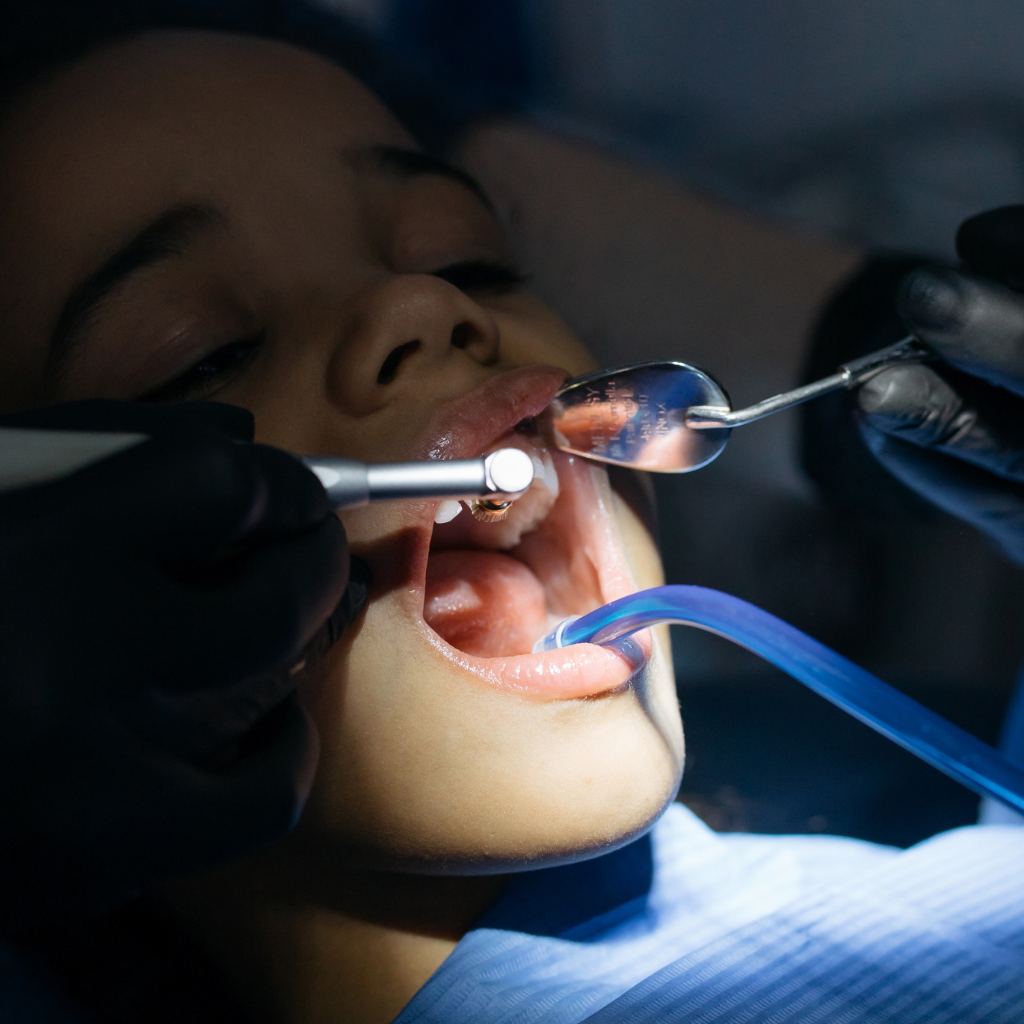Many people wonder what is gum treatment when they face sore, swollen, or bleeding gums. These problems can signal periodontal disease, a condition affecting millions each year. A surprising fact is that periodontal disease can lead to more serious health issues, such as heart disease, if left untreated.
Our article explains how to tackle periodontal disease and care for your gums properly. It provides actionable tips and breaks down the available treatments for readers seeking relief.
Keep reading to discover how you can prevent gum disease and maintain healthy gums.
What is Gum Disease and Its Causes?
Moving from the basics of dental health, let’s explore gum disease and its origins. Gum disease, also known as periodontal disease, affects the tissues and bones that support teeth.
It begins with bacterial growth in your mouth and can end in tooth loss if untreated. The main cause behind this condition is plaque buildup on teeth. Plaque harbours harmful bacteria that can harm gum tissue.
Brushing and flossing daily are critical to removing plaque. Yet, certain factors like smoking, diabetes, hormonal changes in women, medications reducing saliva flow, various illnesses affecting immune systems (such as cancer or AIDS), and genetic susceptibility elevate the risk of developing gum disease.
Early detection through regular dental check-ups enables prompt treatment to prevent serious damage.
Preventing gum disease begins with understanding how everyday habits contribute to its development.
Understanding the Causes of Gum Disease
Gum disease starts when plaque builds up along the gum line. Plaque is a sticky film filled with bacteria. This buildup can lead to gum inflammation, known as gingivitis, a mild form of gum disease.
If not treated properly, gingivitis can progress to periodontitis. That’s a more severe stage where the gums pull away from the teeth, forming spaces called pockets that can become infected.
Several factors can increase your risk of developing gum disease. Poor oral hygiene stands out as a major cause since it allows plaque to remain on your teeth longer, causing more damage.
Smoking also plays a significant role in gum disease development and makes treatment less successful. Other risk factors include:
- Diabetes.
- Hormonal changes in women.
- Certain medications that reduce saliva flow.
- Genetic susceptibility.
- Conditions that weaken immunity, such as HIV/AIDS or leukaemia.
Brushing twice daily and flossing once per day are crucial steps in preventing this buildup and infection.
The Different Stages of Gum Disease
Gum disease starts with gingivitis, which involves swollen gums and bleeding during brushing. This early stage is when bacteria build up along the gum line, causing inflammation. If not treated, gingivitis can progress to periodontitis.
In this more severe stage, the inner layer of gum and bone pulls away from teeth, creating pockets. These pockets can collect debris and become infected.
As periodontitis progresses, pockets deepen due to the loss of supporting bone and tissue around teeth. This may lead to tooth looseness or loss as the jaw bone deteriorates further without proper treatment.
Recognizing these early stages enables timely intervention by a dental professional like a dentist or periodontist who specializes in treating such conditions. Brushing and flossing play crucial roles in preventing gum disease from advancing beyond gingivitis into more serious stages that require extensive treatment.
How Brushing and Flossing Affect Gum Health
Moving from understanding the stages of gum disease, it’s crucial to explore how routine dental care plays a role in maintaining gum health. Brushing your teeth daily and flossing regularly are fundamental habits for preventing the buildup of dental plaque.
This sticky film of bacteria can lead to gingivitis, an early stage of gum disease, if not properly removed.
Good oral hygiene practices, such as brushing and flossing. Disrupt the colonies of harmful bacteria that reside on tooth surfaces and around the gum line. Without these essential steps in your oral care routine, bacteria continue to thrive, producing toxins that irritate and inflame the gums.
Inflamed gums can begin to pull away from the teeth, creating pockets where bacteria can gather. By keeping up with brushing at least twice a day and flossing once daily, you protect your gums from potential inflammation and infection.
Preventing periodontal disease starts with effective plaque control through diligent brushing and flossing.

What Are the Symptoms of Periodontal Disease?
Periodontal disease, also known as gum disease, shows several warning signs that should not be ignored. Bad breath or a bad taste in the mouth can often be the first clues. Gums might bleed easily when brushing or flossing, appearing red and swollen.
As periodontal disease progresses, gums may pull away from teeth, creating spaces called pockets that are prone to infections. In more advanced stages, this condition can cause the loosening of teeth or even result in tooth loss due to bone loss around the tooth roots.
Recognizing early signs is crucial for preventing advanced gum disease. Pain when chewing and sensitive teeth are telltale symptoms, signaling that it’s time to consult a dentist or periodontist.
Early intervention can prevent severe damage, such as bone loss, and help maintain healthy gum tissue. Regular dental check-ups play a vital role in identifying these symptoms before they escalate into serious conditions requiring surgical treatments like pocket reduction surgery or guided tissue regeneration for lost bone and soft tissues.
Recognizing Early Signs of Gum Disease
Gum disease often starts quietly, showing signs that might go unnoticed at first. You may see your gums becoming swollen, red, or bleeding during brushing and flossing. These early symptoms suggest the presence of gingivitis, a mild form of gum disease.
Ignoring these warning signs allows the condition to progress to periodontitis, potentially leading to more severe complications like gum recession and loose teeth.
Regular dental check-ups play a crucial role in detecting these early stages before they escalate. Dentists use tools like periodontal probes and dental X-rays to evaluate for gum disease and recommend appropriate treatment.
Catching gum disease early can prevent it from causing irreversible damage, such as loss of tooth enamel and underlying bone deterioration. Managing it with proper treatment can keep your oral health on track and save you from advanced periodontal treatment later on.
How Periodontal Disease Can Cause Gum Recession
Periodontal disease starts when bacteria cause gum inflammation, leading to the formation of periodontal pockets. These pockets allow more bacteria to gather, worsening the infection and causing the gums to shrink back.
As gums recede, teeth roots become exposed, increasing sensitivity and risk for further damage. Treating periodontal disease early can prevent this severe consequence.
Managing gum disease effectively is crucial in preventing loss of gum tissue.
Early detection by a dentist or dental hygienist plays a crucial role in maintaining healthy gums and preventing recession. Next up is understanding when it’s time to consult with a professional for treatment options.
When to Consult a Dentist or Periodontist
You should see a dentist regularly to catch signs of gum disease early. Gum disease can start silent, but a dentist might spot redness, gum pockets forming, or swollen gums during check-ups.
They use tools like the periodontal probe to assess for periodontal disease and recommend suitable treatment before it gets worse. If your gums bleed when you brush or floss, it’s a signal that you shouldn’t ignore.
These symptoms could hint at gingivitis, the initial stage of gum disease, which is much easier to manage than severe periodontitis.
Dentists also play a crucial role in treating more advanced cases by performing deep cleanings known as scaling and root planing. This process involves cleaning below the gumline and smoothing root surfaces where bacteria hide and cause damage.
For those with deeper pockets that do not heal after non-surgical treatments or with significant bone loss, being referred to a periodontist may be necessary. Periodontists specialize in diseases of the gum and bone around teeth; they offer surgical options like flap surgery or grafts to repair damage from periodontitis.
What Are the Available Treatment Options?
Treating gum disease depends on its stage. Early gum disease, or gingivitis, often improves with regular dental cleanings and better home care. Dentists may suggest using special toothbrushes, interdental brushes, or oral antibiotics to fight the bacteria causing the problem.
For more advanced periodontitis, non-surgical treatments like scaling and root planing help remove plaque below the gum line. This process can be done with local anaesthetic to minimize discomfort.
Surgical options become necessary when the disease has caused significant damage. Gum graft surgery repairs gums that have shrunk away from teeth. In severe cases where there is a loss of bone supporting the teeth, procedures such as bone grafts help promote healthy bone regeneration.
Dental implants might replace lost teeth due to severe periodontal disease, ensuring both function and cosmetic appearance are restored.

Non-Surgical Gum Disease Treatment Options
Gum disease needs attention to prevent it from worsening. Managing it with proper treatment can help maintain your oral health.
- Professional dental cleanings play a crucial role in treating gum disease by removing plaque and tartar from above and below the gum line. These cleanings, often recommended twice a year, can significantly reduce the likelihood of developing periodontitis.
- Scaling and root planing is a deep-cleaning procedure that targets bacterial toxins beneath the gums. This method involves scraping away tartar from above and below the gum line and smoothing rough spots on the tooth roots where germs tend to accumulate.
- Using an ultrasonic device, dentists can break up plaque and tartar. This tool vibrates at a high frequency to remove buildup without harming your own bone or gum tissue.
- Antibacterial mouth rinses become part of daily oral hygiene for those prone to gum disease. They help control bacteria that cause gum disease, minimizing inflammation and preventing diseased tissue.
- Dental lasers offer a modern approach to removing diseased tissue without the need for surgery. Laser therapy can reduce bacteria levels and promote healthy gum reattachment to teeth surfaces.
- Applying topical antibiotics directly onto gums helps fight infection right at its source. These antibiotics target the gums to shrink around the teeth, reducing pockets and eliminating bacteria.
- Adjusting your diet to include foods that support developing tooth enamel can also benefit gums. A healthy diet influences overall dental health by strengthening teeth against bacterial attacks.
- Quitting smoking is critical for individuals looking to treat or prevent gum disease. Smoking contributes significantly to gum disease development by weakening the immune system, making it more difficult for your body to fend off infections.
- Practising good oral hygiene remains the foundation of preventing and treating periodontal disease. Brush your teeth twice a day, floss regularly, and use mouthwash to manage bacteria levels in your mouth effectively.
Implementing these non-surgical treatments requires commitment but is vital in managing gum disease effectively before it escalates, requiring more intensive interventions like dental surgery or even losing teeth.
The Role of Scaling and Root Planning
Dentists use scaling and root planning to treat gum disease before it gets worse. This non-surgical treatment helps remove plaque and tartar from below the gumline. Tools are used to clean out bacteria that lead to periodontitis.
It’s a way to stop gum disease from causing more bone loss or leading to tooth loss.
After cleaning, dentists smooth the roots of your teeth. This process helps your gums reattach to your teeth. Scaling and root planning can manage gum disease if caught early. It takes skill, but our team is trained in these techniques.
This treatment can save teeth and prevent the need for surgery later on.
Surgical Treatments for Advanced Periodontitis
Advanced periodontitis requires more than just daily brushing and flossing to manage. Surgical treatments often become necessary to save teeth and improve oral health.
- Flap surgery, also known as pocket reduction surgery, involves lifting the gums back to remove tartar buildup. This process allows dentists to reduce the depth of the gum pockets.
- In cases where disease has destroyed the bone surrounding your tooth root, a bone graft may be used. This procedure helps regenerate lost bone and can involve natural or synthetic bone.
- Soft tissue grafts focus on reinforcing thin gums or filling in areas where the gums have receded. Grafted tissue, often taken from the roof of the mouth, is stitched in place, adding tissue to the affected area.
- Guided tissue regeneration is done when the bone supporting your teeth has been destroyed. This method uses a biocompatible fabric placed between the bone and tooth, allowing the bone to regrow and support the teeth better.
- Applying a protein-containing gel to a diseased tooth root can stimulate the healthy growth of bone and tissue at the site.
- For patients with exposed roots due to gum recession, a dentist may perform root planing. Root planing smooths out rough spots on a tooth’s root where bacteria gather, helping prevent further gum disease.
- Crown lengthening might be recommended to reshape excess gum and bone tissue. This procedure can expose more of a tooth’s surface for other necessary treatments, such as crowns or bridges.
Gum surgery can play a crucial role in treating periodontitis and preventing tooth loss. Each treatment option aims at restoring your oral health by tackling underlying issues causing gum disease.
How to Prevent Gum Disease?
Preventing gum disease starts with understanding its causes, like poor oral hygiene and genetics. Regular dental check-ups play a crucial role in catching signs of gum disease early.
These visits allow dentists to perform exams using tools such as a periodontal probe, which is essential for detecting problems before they worsen. Patients often underestimate the power of these routine checks, but they can make a big difference in preventing periodontitis.
Maintaining good oral health involves more than just brushing and flossing daily; it requires lifestyle changes, too. Reducing risk factors such as smoking and improving your diet supports stronger teeth and gums.
Regular dental cleanings remove plaque and tartar that brushing alone can’t reach, safeguarding against the leading cause of gum recession. This combination of professional care and personal habits helps manage gum health effectively, keeping periodontal disease at bay.
The Importance of Routine Dental Check-Ups
Routine dental check-ups play a critical role in preventing gum disease and maintaining overall oral health. Experts agree that visiting your dentist regularly helps catch signs of gum disease early when it’s most manageable with proper treatment.
These visits allow dentists to use tools like a periodontal probe to evaluate the health of your gums and teeth. They can identify early signs of problems, such as swollen gums or deep pockets around teeth, which are key indicators of potential issues.
During these appointments, dentists also discuss your treatment options and advise on how to avoid advancing gum disease by changing daily oral hygiene habits. This proactive approach helps prevent the need for more complex and invasive treatments down the line.
Maintaining oral health with regular dental cleanings is next in ensuring long-term dental wellness.
Maintaining Oral Health with Regular Dental Cleanings
Regular dental cleanings play a crucial role in preventing gum disease, which is the leading cause of tooth loss. Dental professionals use tools to eliminate plaque and tartar that home brushing cannot eradicate.
These cleanings aid in identifying initial signs of gum disease, including swollen gums or recession, permitting prompt handling with suitable treatment. Dentists also give valuable tips for bettering brushing and flossing techniques during these visits.
Preventive actions like regular dental cleanings significantly lower the risk of developing periodontitis.
Dental examinations twice a year are advised to keep oral health in check and avoid conditions related to gum disease. Professionals might advise more recurrent visits if you’re prone to gum disease due to family history or other elements.
During these meetings, dentists utilize a periodontal probe to measure gum pockets and decide on the most suitable action plan, ensuring personalized attention for each patient’s requirements.
Preventive Measures and Lifestyle Changes
Gum disease is a leading cause of tooth loss if not addressed properly. Adopting preventive measures and making lifestyle changes can significantly reduce your risk of developing periodontitis and maintain your gum health.
- Schedule routine dental check-ups at least every six months. These visits allow dentists to catch early signs of gum disease.
- Get professional dental cleanings during these check-ups. Cleanings remove plaque and tartar that brushing alone can’t eliminate.
- Brush your teeth twice a day with fluoride toothpaste to help prevent plaque and tartar buildup, a major cause of periodontal disease.
- Floss daily to remove food particles and plaque between teeth that your toothbrush can’t reach.
- Use a mouthwash recommended by your dentist to reduce plaque buildup and keep gums healthy.
- Quit smoking. Smoking increases the risk of gum disease, reducing it weakens your immune system, making it harder for your body to fight off infections, including periodontal diseases.
- Eat a balanced diet rich in vitamins and minerals from fruits, vegetables, lean proteins, and whole grains to support healthy gums.
- Limit sugary snacks and beverages as they contribute to plaque formation, which is a key player in gum disease development.
- Wear a mouthguard if you grind your teeth at night, as grinding can damage teeth and aggravate gum conditions.
- Manage stress since high stress levels may make it difficult for your body’s immune system to fight off infections, including those causing gum disease.
Implementing these steps will greatly contribute to preventing gum disease, ensuring you maintain healthy gums and keep your smile intact for years to come.
What is the Role of Gum Surgery in Treatment?
Gum surgery often turns out to be necessary when non-surgical treatments fail to control periodontitis effectively. Dentists suggest this choice to halt the disease’s progress and prevent further harm to the gums and bones.
This operation aids in the rebuilding of lost tissue and bone, acting as a guard against tooth loss. Taking gum graft surgery as an example, it serves to cover bare roots, slow down gum regression, and shield susceptible teeth from decay.
It’s integral in assisting patients in regaining their oral health.
Patients can witness substantial enhancements post-gum or bone tissue generation procedures. These surgical methodologies restore function and, in the process, improve the aesthetics of one’s smile.
Appropriate care following surgery is vital for a rapid recuperation process and to affirm the enduring success of the treatment. We now move on to discuss how upholding good oral hygiene after the treatment aids in warding off future issues.
When is Gum Graft Surgery Necessary?
Gum graft surgery becomes a requirement when gum disease results in serious gum recession. This situation exposes the roots of teeth, provoking sensitivity and amplifying the danger of root decay.
Gum recession also modifies how your smile appears, which might lead to self-consciousness. If non-surgical approaches do not halt further gum recession, a dentist or periodontist may propose a gum graft.
This procedure safeguards your teeth against further harm and can promote the aesthetic of your smile.
A patient usually requires this surgery if they have lost gum tissue and it’s not naturally regrowing. Loss of gum tissue enhances the likelihood of teeth losing support and falling out, creating grave risks to oral health and exacerbating overall health conditions.
The process comprises transferring tissue from a different part of the mouth and attaching it where the gums have receded. This not only conceals exposed tooth roots but also promotes natural tissue regeneration over time, assisting in preventing tooth loss and managing periodontitis effectively.

Understanding Gum and Bone Tissue Regeneration
Gum and bone tissue regeneration plays a crucial role in managing advanced periodontitis. This process helps restore the support your teeth need after they lose it from gum disease.
Dentists use advanced techniques to encourage your body to regenerate lost gum tissues and bone. This can include placing membranes, grafts, or tissue-stimulating proteins that promote your body’s natural ability to heal and rebuild the affected areas.
These treatments aim to reverse some of the damage caused by periodontal disease. For patients who have experienced significant bone loss or where gums have receded severely, regeneration offers a way to improve oral health and prevent tooth loss.
The success of these procedures often depends on early detection and treatment of gum disease, highlighting the importance of regular dental check-ups and cleanings to catch problems before they escalate.
Post-Surgery Care and Recovery Process
After understanding gum and bone tissue regeneration, the next crucial step is focusing on the post-surgery care and recovery process. Proper treatment after surgery ensures that your gums heal correctly and reduces the risk of complications.
- Keep the surgical area clean. Brush gently around the site and use any special mouthwash your dentist recommends to prevent infection.
- Manage swelling by applying cold packs to your face in the first 24 hours after surgery. This can also help reduce pain.
- Follow a soft food diet for a few days post-surgery. Foods like yoghurt, soup, and applesauce are good choices as they require minimal chewing.
- Avoid smoking entirely, as it can delay healing and increase the risk of infection. Smoking is a leading cause of gum disease recurrence.
- Limit physical activity for at least 48 hours after your gum surgery to prevent bleeding or swelling of the surgical site.
- Attend all follow-up appointments so your dentist or periodontist can monitor healing and remove any stitches if necessary.
- Report any signs of infection or unusual symptoms to your dentist immediately. Symptoms include increased pain, swelling, or discharge from the surgical site.
- Take prescribed medications exactly as directed. Pain relievers can manage discomfort, while antibiotics may be necessary to prevent infection.
Following these steps closely will aid in a smooth recovery process, ensuring your gums heal well and contribute to overall oral health maintenance.
Conclusion
Effective gum treatment can prevent the progression of periodontal disease and save your teeth. Non-surgical treatments, along with proper dental care, play a crucial role in managing the early stages of gum disease.
For those who develop periodontitis, advanced options, including surgery, may be necessary to restore oral health. Following a dedicated routine of brushing, flossing, and regular dentist visits is key to avoiding these problems altogether.
Periodontal disease doesn’t have to lead to tooth loss if you manage it with proper treatment from the start. Consulting a dentist or periodontist at the first signs of gum disease can make all the difference.
Take action today for a healthier smile tomorrow by scheduling your next dental check-up.


